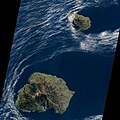Fil:Prince Edward Islands, EO-1 ALI satellite image, 5 May 2009.jpg

Storleik på førehandsvising: 600 × 600 pikslar. Andre oppløysingar: 240 × 240 pikslar | 480 × 480 pikslar | 768 × 768 pikslar | 1 024 × 1 024 pikslar | 2 048 × 2 048 pikslar | 5 000 × 5 000 pikslar.
Opphavleg fil (5 000 × 5 000 pikslar, filstorleik: 5,18 MB, MIME-type: image/jpeg)

Følgjande er henta frå filomtalen åt denne fila på Wikimedia Commons:
Filhistorikk
Klikk på dato/klokkeslett for å sjå fila slik ho var på det tidspunktet.
| Dato/klokkeslett | Miniatyrbilete | Oppløysing | Brukar | Kommentar | |
|---|---|---|---|---|---|
| gjeldande | 28. januar 2013 kl. 23:19 |  | 5 000 × 5 000 (5,18 MB) | Slick-o-bot | Bot: convert to a non-interlaced jpeg (see bug #17645) |
| 5. april 2011 kl. 02:57 |  | 5 000 × 5 000 (5,08 MB) | Avenue | {{Information |Description ={{en|1=Satellite image of South Africa's Prince Edward Islands. Prince Edward Island is the smaller island near the top; Marion Island is the larger island below. Original NASA caption, for a version cropped to show just Ma |
Filbruk
Dei følgjande 3 sidene bruker denne fila:
Global filbruk
Desse andre wikiane nyttar fila:
- Bruk på af.wikipedia.org
- Bruk på ar.wikipedia.org
- Bruk på ca.wikipedia.org
- Bruk på ceb.wikipedia.org
- Bruk på cs.wikipedia.org
- Bruk på da.wikipedia.org
- Bruk på de.wikipedia.org
- Bruk på eo.wikipedia.org
- Bruk på es.wikipedia.org
- Bruk på eu.wikipedia.org
- Bruk på fi.wikipedia.org
- Bruk på fr.wikivoyage.org
- Bruk på it.wikipedia.org
- Bruk på no.wikipedia.org
- Bruk på pl.wikipedia.org
- Bruk på sv.wikipedia.org
- Bruk på ur.wikipedia.org
- Bruk på www.wikidata.org




